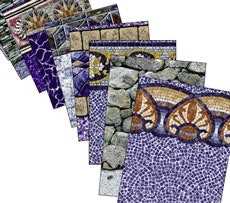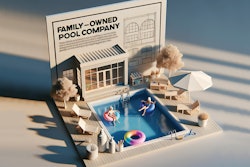
Today's designers have finally had the chains released and we are only limited by our creativity or imagination." Thanks to advancements in technology and the creativity of skilled and educated designers, the variety of patterns and colors seems to grow each year. For 2008, natural textures along with daring colors and outside-the-box imagery characterize the industry's new patterns.
It's clear that one source of ideas for designers and manufacturers is listening to feedback from their customers. Stacked stone and rock-wall designs give homeowners tools for matching natural stone in their landscapes. Selections of colors let builders match the vinyl pattern to the coping rather than the other way around. In fact, one major supplier, Canadian General- Tower, hosted a pattern preview gala last summer to gather input from its customers.
The design showcase was installed in a gallery space and customers were invited to see - and comment on - a selection of designs, some of which eventually made it into production. "It is extremely important to us that we receive as much feedback on our designs as possible. Good and bad," says Roman Laufer, one of two fulltime designers at CGT.
At HPG, designer Steve Leavitt values customer feedback, but sometimes it's hard to interpret. "While we do get customer feedback, it's amazing how much the results can vary. One [customer] will do well with a modern pattern while another will do great with an art deco or antiquedlooking mosaic," he says.
Leavitt's colleague Calnan says it all comes down to appealing to the masses. "Some patterns will sell better in specific regions, while others will have a broader appeal because the pattern's colors and textures relate to more of a variety of regional materials used around pools," she says. "It's not an exact science but we can greatly improve the odds something will sell well by keeping abreast of color and outdoor living trends and just by talking to people, from customers to installers to end consumers."
While some of the "chains" Calnan mentioned were technological constraints that have now been overcome, habit and tradition can also stand in the way of innovation. But as consumers see more and different patterns, it seems it whets their appetites for yet more variety.
"Tile patterns used to follow a basic standard of 9 inches in height. When the pool was properly filled to the recommended level, the waterline would hit the midpoint of the tile, and you would get a reflection that would complete the pattern," says Leavitt. "Most of the patterns were one simple tile, flipped four ways and positioned to create a circular center motif. As tile patterns evolved away from the simplistic early designs, it became less of a visual factor. A popular development over the past few years has been tile heights of 6 inches, commonly referred to as 'above the waterline' tiles. As with all of the various tile heights, it's merely aesthetic. As a designer, the beauty of the 9-inch rule going out the window is that we can unleash our creativity in new ways. We can do a tile of any height from 6 inches to the entire sidewall."
And ideas - whether the 6-inch variety or the full wall-height ones - can come from anywhere. CGT's Laufer takes numerous trips across North America in search of visual ideas. On one such trip to Chicago, he was inspired by a tile design in an El stop. Lincoln Park is a new pattern resulting from that moment on a train platform.
Even though computers and hightech processes make complicated designs possible, the artist behind the ideas is irreplaceable. "A designer needs to find the perfect balance between great textures and design elements, while recognizing the parameters and limitations of gravure printing technology. It takes minutes to understand the technique, yet years to perfect," says Leavitt. "The best compliment I ever received from a customer was being told that one of their clients asked if 'it costs any extra for the 3-D effect.'"







































